Finding a rare 1943 copper penny is like striking gold—literally. These coins are among the rarest and most valuable Lincoln cents ever produced. Because of their scarcity and high demand among collectors, knowing how to identify, grade, and evaluate them properly is essential.
Overview of the 1943 Copper Penny
- Type: Wheat Penny
- Mint Locations: Philadelphia, Denver, San Francisco
- Total Estimated Mintage: Only 26 known
- Obverse Designer: Victor D. Brenner
- Reverse Designer: Victor D. Brenner
- Composition: 95% copper, 5% tin and zinc
- Weight: 3.11 grams
- Diameter: 19 mm
- Thickness: 1.5 mm
- Edge: Smooth
Why It’s So Rare
In 1943, due to wartime demands, the U.S. Mint switched from copper to zinc-coated steel to preserve copper for ammunition and equipment. However, a few bronze planchets (used in 1942) accidentally remained in the machinery, resulting in the extremely rare 1943 copper pennies.
First Step: Know What to Look For
Before you can even begin valuing a 1943 copper penny, it’s important to familiarize yourself with its authentic characteristics:
- A genuine copper 1943 penny should not be magnetic.
- It should weigh around 3.11g, not the 2.7g of the steel version.
- Visual clues include a brown or reddish tone, as opposed to the silvery gray of the steel version.
- Carefully inspect the mint mark and date. Fakes often alter a 1948 coin to resemble 1943.
The Obverse
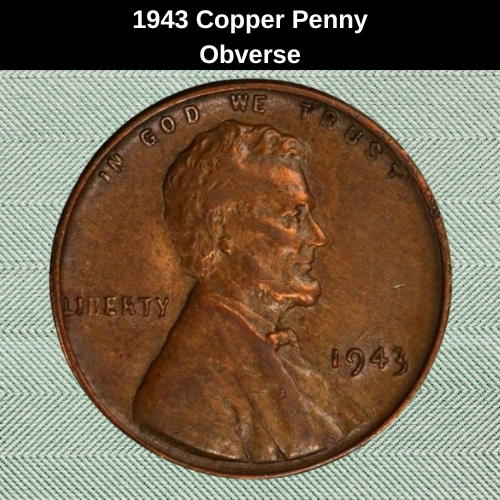
On the obverse of the 1943 copper penny, you’ll see a right-facing portrait of President Abraham Lincoln, dressed in a suit and bow tie, symbolizing statesmanship and dignity. This iconic image has been a staple of the Lincoln cent since its introduction in 1909.
Above Lincoln’s head is the patriotic motto “IN GOD WE TRUST,” emphasizing national unity and faith. To the left, near Lincoln’s shoulder, is the word “LIBERTY,” a core value of the United States. On the right side, in front of Lincoln’s chest, is the minting year, 1943, marking this coin’s extremely rare production during wartime.
All these elements were meticulously crafted by Victor D. Brenner, whose initials, V.D.B., can often be found at the base of Lincoln’s shoulder on some editions of the penny.
The Reverse
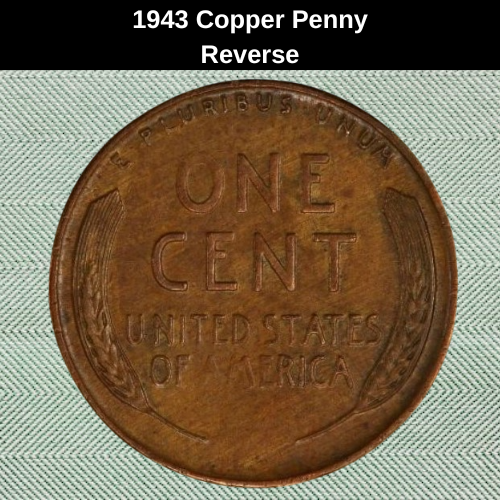
Recognizing the reverse of the 1943 copper penny is just as important as identifying the obverse, especially when confirming its authenticity.
At the center, you’ll see the coin’s denomination:
“ONE CENT” — large and bold.
Above that is the classic American motto:
“E PLURIBUS UNUM” — meaning “Out of many, one”, arched near the top edge.
Below the denomination appears:
“UNITED STATES OF AMERICA” — identifying the issuing nation.
Framing the entire design are two stylized wheat stalks, one on each side, curving inward. These wheat sheaths are the hallmark of the “Wheat Penny” design, which was used from 1909 to 1958. It’s because of these wheat ears that the 1943 copper penny earns its nickname — the Wheat Cent.
These simple but symbolic elements reflect the agricultural roots and unity of the United States, all crafted by Victor D. Brenner.
| 1943 Copper Penny Value Chart | ||||
| Mint mark | XF45 | AU55 | AU58 | MS64 |
| 1943 No Mint Mark Copper Penny | $225,000 | $360,000 | $375,000 | – |
| 1943 D Copper Penny | – | – | – | $105,000 |
| 1943 S Copper Penny | $185,000 | $275,000 | $350,000 | – |
1943 Copper Penny Grading
Even though authentic 1943 copper pennies are exceedingly rare, grading plays a critical role in identifying their true market value — especially if you’re lucky enough to find one.
Here’s how grading works for these coins:
- Good (G): These coins show heavy wear. The design is visible but faint in some areas. They’re often classified around Grade 4 to 6.
- Fine (F): Light to moderate wear with sharper details. You might notice minor scratches or smoothing — these coins fall into Grades 12 to 15.
- Very Fine to Extremely Fine (VF–EF/XF): These grades (20 to 40) indicate minimal circulation with sharp detail, but still some evidence of handling.
- About Uncirculated (AU): With Grade 50, these coins were only lightly handled — no actual wear, just tiny contact marks.
- Mint State (MS 60 to 70): These are the highest grades — the coin was never circulated. MS 65 and above can fetch astronomical prices, especially for rare coins like the 1943 copper penny.
Here’s a simplified scale recap:
| Grade Number | Description |
|---|---|
| 1 | Basal State-1 |
| 2 | Fair |
| 3 | Very Fair |
| 4–6 | Good |
| 7–10 | Very Good |
| 12–15 | Fine |
| 20–30 | Very Fine |
| 40 | Extremely Fine |
| 50 | About Uncirculated |
| 60–70 | Mint State |
✅ Tip: Never clean your coin — this decreases its grade and value!
📏 Action Step: Use a coin scale, caliper, and magnifying glass — then consult a professional grading service like PCGS or NGC for authentication.
1943 Copper Penny Value and Varieties Guide
Knowing only the physical characteristics of the 1943 copper penny isn’t enough to determine its true value. It’s equally important to recognize the different varieties in circulation, as these variations can significantly impact the coin’s worth.
1943 No Mint Mark Copper Penny Value
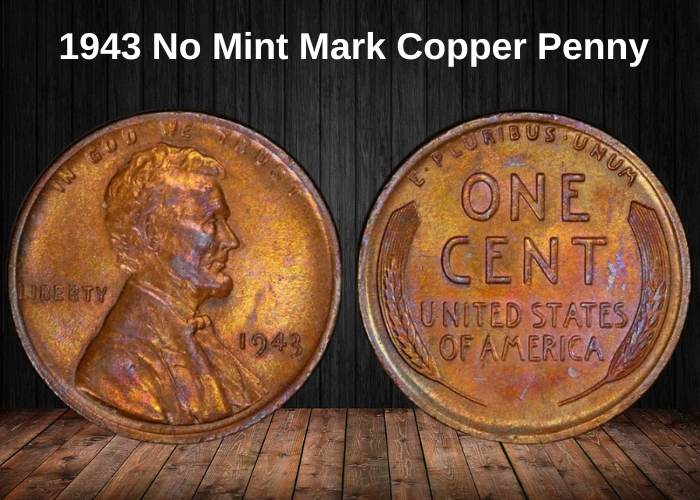
Category: Wheat Penny
Edge: Smooth
Mint Mark: None
Minting Location: Philadelphia
Year: 1943
Face Value: 1 Cent
Melt Value: $0.0269
Quantity Produced: 20
Designer: Victor D. Brenner
The 1943 copper penny without a mint mark is one of the rarest coins ever struck in the United States. Its rarity directly contributes to its high value—and if you’re lucky enough to own one, it could mean a small fortune.
Most 1943 pennies were made of steel due to wartime metal shortages. However, a few copper planchets from 1942 accidentally remained in the minting presses, resulting in a handful of 1943 copper pennies. Of those, 20 are known to have come from the Philadelphia Mint, making this the most frequently discovered variety—though it’s still extremely rare.
Some experts believe more may exist, but they’ve yet to be found. The few confirmed examples have sold for incredibly high prices, especially depending on their condition.
For example:
- An extremely fine 1943 copper penny can be worth around $225,000.
- In about uncirculated (AU50) condition, its value climbs to $260,000.
- A coin graded MS60 can fetch up to $390,000.
In one notable auction in 2014, a 1943 copper penny graded AU55 sold for an astonishing $329,000.
1943 D Mint Mark Copper Penny Value
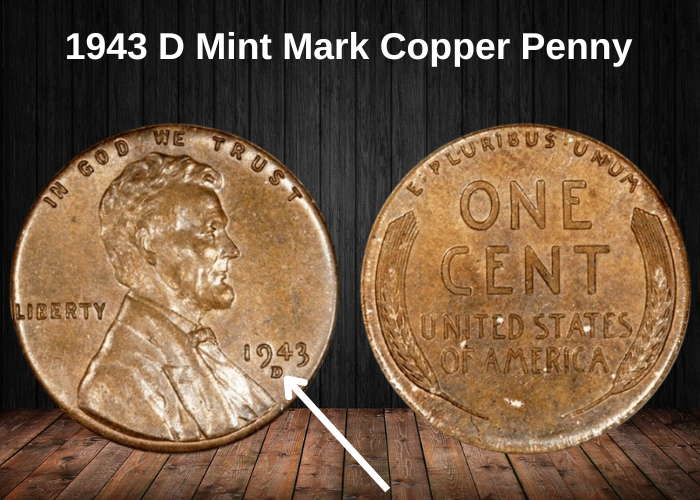
Category: Wheat Penny
Edge: Smooth
Mint Mark: D
Minting Location: Denver
Year: 1943
Face Value: 1 Cent
Melt Value: $0.0269
Quantity Produced: 1
Designer: Victor D. Brenner
The 1943 copper penny struck at the Denver Mint is the rarest of all 1943 copper cents. Only one confirmed example is known to exist, making it not just the scarcest of its kind but also the most valuable.
Like its Philadelphia counterpart, this unique coin was created due to a leftover copper planchet accidentally being used during the transition to steel cents in 1943. It’s important to remember that this coin’s true value lies in its rarity and condition—melting it down would only leave you with a few cents’ worth of copper.
In 2010, this legendary coin sold for $1,750,000. Since then, its estimated value has nearly doubled, reflecting its unmatched status among American coins.
1943 S Mint Mark Copper Penny Value
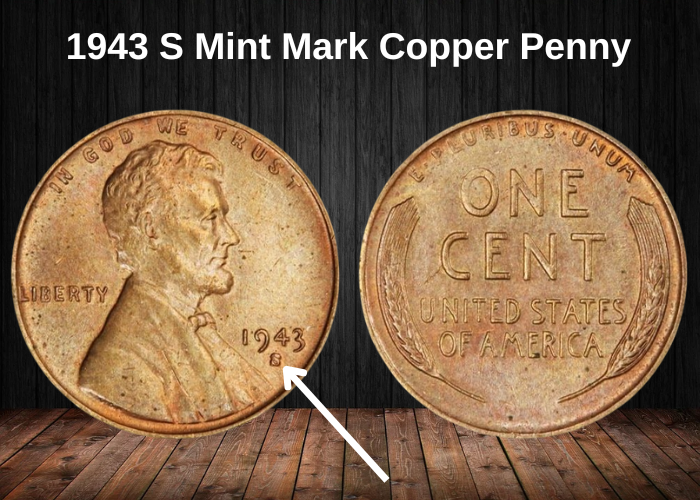
Category: Wheat Penny
Edge: Smooth
Mint Mark: S
Minting Location: San Francisco
Year: 1943
Face Value: 1 Cent
Melt Value: $0.0269
Quantity Produced: 5
Designer: Victor D. Brenner
The San Francisco Mint produced only five verified examples of the 1943 copper penny. These rare coins rank among the most valuable ever documented. While rarer than the Philadelphia variety, they’re slightly more common than the single Denver specimen.
An extremely fine 1943-S copper penny is valued at approximately $175,000. If the coin is uncirculated but in a lower grade such as AU50, it can fetch around $200,000. Higher grades, like MS63, have been known to reach $1,000,000 on the coin market.
Finding a higher-grade example would likely make it the most valuable known 1943-S copper penny. One such coin was sold by Heritage Auctions in January 2018 for an impressive $228,000.
1943 Copper Penny History
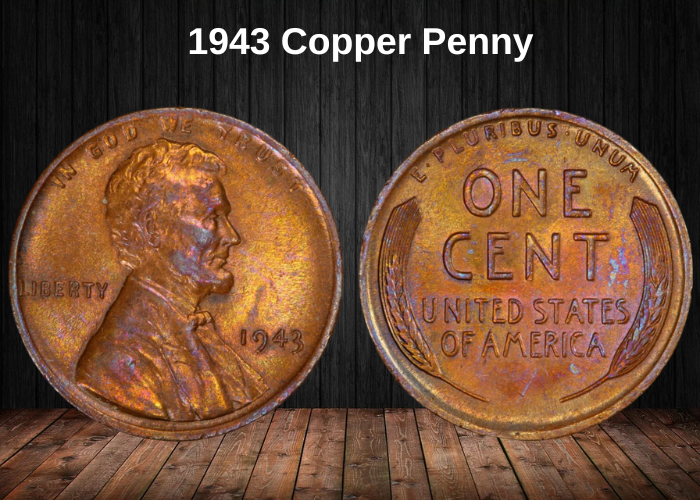
In addition to being known as fortune-making pennies due to the fascinating history surrounding their creation and circulation, the 1943 copper pennies are also considered error coins because of how they came to exist.
During World War II, the U.S. government decided to use only steel to mint coins. This measure was taken to conserve copper, which was urgently needed for producing armor for soldiers on the frontlines.
The “error” that led to the creation of these rare coins occurred when copper planchets, which had been left in the press hoppers, were accidentally used to mint pennies in 1943, before the switch to steel took full effect. Interestingly, this error took place across all three mints, which has sparked debate about whether these coins should really be classified as “error coins” at all.
As soon as these limited mintage copper pennies were released, they became highly valuable due to their rarity. Collectors were eager to understand why they were so scarce, which caused demand to soar, driving up their prices.
A rumor circulated in the late 1940s that Henry Ford, the owner of the Ford Motor Company, was interested in these rare pennies and would reward anyone who found one with a car. While this legend contributed to their allure, finding a 1943 copper penny was no easy feat. It wasn’t until 1944 that collectors first confirmed their existence when a 14-year-old discovered one in extra fine condition. This coin was sold for an impressive $40,000 at the time.
While rumors suggest that up to 40 coins were struck, only 26 verified pieces are currently known. Of these, 20 were minted at the Philadelphia Mint, 5 at the San Francisco Mint, and 1 at the Denver Mint.
It’s important to note that counterfeit versions of these coins are common. Many fakes are made by copper-plating ordinary pennies, while others are pennies from different years that have been filed down to resemble the 1943 copper penny. Here are four key ways to verify the authenticity of a 1943 copper penny:
- Magnet Test: Unlike the steel version of the 1943 penny, which is magnetic, a genuine 1943 copper penny will not attract a magnet.
- Long-Tailed Appearance: The “3” in 1943 on genuine copper pennies often has a long-tailed appearance.
- Weight Test: A real copper penny weighs 3.11g, while a steel penny weighs only 2.70g.
- Strike Quality: Because soft copper planchets were used, the strike quality of genuine copper pennies is typically sharper and crisper than the steel versions, which were made under the same minting pressure.
Rare 1943 Copper Penny Error List
One verified error coin from the 1943 copper penny category is the die crack error located at the bottom of the coin’s obverse side. This error features a visible die break, which many collectors refer to as the cud of the obverse.
The mistake occurred during the minting process at the Philadelphia Mint, when the planchet metal shifted, creating a blob on the coin’s surface. This blob interfered with the design, cutting off part of Lincoln’s coat. Because of the uniqueness of this error, the coin has been graded MS62 by the NGC and is valued at approximately $575,000.
The coin once belonged to Albert Michael Pratt, who worked at the U.S. Mint during the period when the 1943 copper pennies were produced. After his passing, the coin was inherited by his son, who received this rare and valuable piece of history.
Where to sell your penny?
Now that you know the value of your penny, you might be wondering where to sell it. Don’t worry: here’s a guide to some of the best online platforms where you can easily sell your coins, along with their advantages and disadvantages.
Discover the best platforms for selling coins online (pros and cons).
1943 Copper Penny FAQs
1. Why is the 1943 Copper Penny so valuable?
The 1943 Copper Penny is exceptionally rare because it was supposed to be made of zinc-coated steel due to a copper shortage during World War II. However, a few copper planchets (blanks) intended for other coins accidentally got struck with the 1943 Lincoln Penny design. As a result, these pennies were made from copper, which was completely out of line with the minting instructions at the time. Only about 20 to 30 examples are known to exist, which makes them highly valuable to collectors. In good condition, a 1943 copper penny can fetch hundreds of thousands of dollars at auction, with some selling for millions in top grades.
2. How can you tell a 1943 Copper Penny from a regular 1943 Steel Penny?
The 1943 Copper Penny can be identified by several key differences:
- Color: The 1943 copper penny has a brownish, reddish hue, whereas the steel penny is a silver color due to the zinc coating.
- Weight: The copper penny weighs about 3.11 grams, the same as typical pre-1943 pennies. In contrast, the steel penny weighs around 2.7 grams, as it is made of steel and coated in zinc.
- Magnetic Test: The 1943 steel pennies are magnetic because of their steel composition, while the copper penny is not magnetic.
3. How many 1943 Copper Pennies were minted?
There was no official production of copper pennies in 1943, but a small number were accidentally struck with copper planchets that were left over from the previous year. The exact number is unknown, but it is widely believed that around 20 to 30 coins were produced. The most famous example, the 1943 copper penny in MS-64 condition, was sold for over $1 million in a private auction in 2010.
4. How much is a 1943 Copper Penny worth today?
The value of a 1943 Copper Penny depends on its condition, but even in poor condition, it can fetch several hundred thousand dollars. Uncirculated or high-grade examples have sold for over $1 million. The value is largely driven by its rarity and the unique historical context behind its production. The highest value recorded for a 1943 copper penny was $1.7 million for a coin in MS-64 condition.
5. Are there any other ways a 1943 Copper Penny can be faked?
Yes, due to the extreme value of the 1943 Copper Penny, counterfeit versions do exist. One common method of creating a fake involves altering a 1943 steel penny by polishing it or coating it with copper to mimic the look of a genuine copper penny. To detect a fake, collectors and professionals typically use several tests:
- Weight Test: Authentic 1943 copper pennies weigh about 3.11 grams.
- Magnet Test: Steel pennies are magnetic, while copper pennies are not.
- Professional Authentication: Getting the coin authenticated by organizations like PCGS (Professional Coin Grading Service) or NGC (Numismatic Guaranty Corporation) is essential for confirming authenticity.
6. Why did the U.S. Mint switch to steel pennies in 1943?
In 1942, copper became a critical material for the production of military ammunition, and the U.S. Mint was instructed to stop using copper for non-essential coins. To continue producing pennies without wasting copper, the U.S. Mint switched to zinc-coated steel for the 1943 pennies. This move allowed the Mint to conserve copper while still minting a circulating currency, thus contributing to the war effort. After the war, the U.S. Mint returned to copper for the 1944 penny.
7. What makes the 1943 Copper Penny different from the 1943 Steel Penny?
While the 1943 Steel Penny was part of the wartime effort to conserve copper, the 1943 Copper Penny is an error coin. The steel penny was intended to be made from zinc-coated steel, and millions of them were produced, with most of them entering circulation. The copper pennies, however, were accidentally struck on leftover copper planchets, which were meant for the 1942 coins. Thus, the 1943 Copper Penny is extremely rare, while the steel version is more common and of relatively low value (usually worth only a few cents).
8. Where are 1943 Copper Pennies found today?
Most 1943 copper pennies were either destroyed or lost over the years due to their similarity to regular copper pennies. As a result, only a small number of these coins have survived in private collections and are occasionally offered for sale at auction houses or through specialized numismatic dealers. The discovery of a 1943 copper penny is extremely rare, and when one is found, it is often the subject of extensive media attention.
9. How did the 1943 Copper Penny become so famous in popular culture?
The 1943 Copper Penny became famous because of its rarity and historical significance as a minting error. Its value in the numismatic market has turned it into one of the most sought-after error coins in American coin collecting. Its story has been covered extensively by the media and is frequently mentioned in discussions about rare coins and valuable collectibles, further cementing its place in popular culture as one of the most famous American coins.
10. What makes the 1943 Copper Penny so important to coin collectors?
The 1943 Copper Penny represents both rarity and history, two key aspects that make it especially important to coin collectors. Its accidental creation highlights how even the smallest mistakes in coin production can lead to incredibly valuable items, and its historical context ties it to the wartime era of the United States. For collectors, finding or owning a 1943 copper penny is like possessing a piece of American history with immense numismatic value.



















































